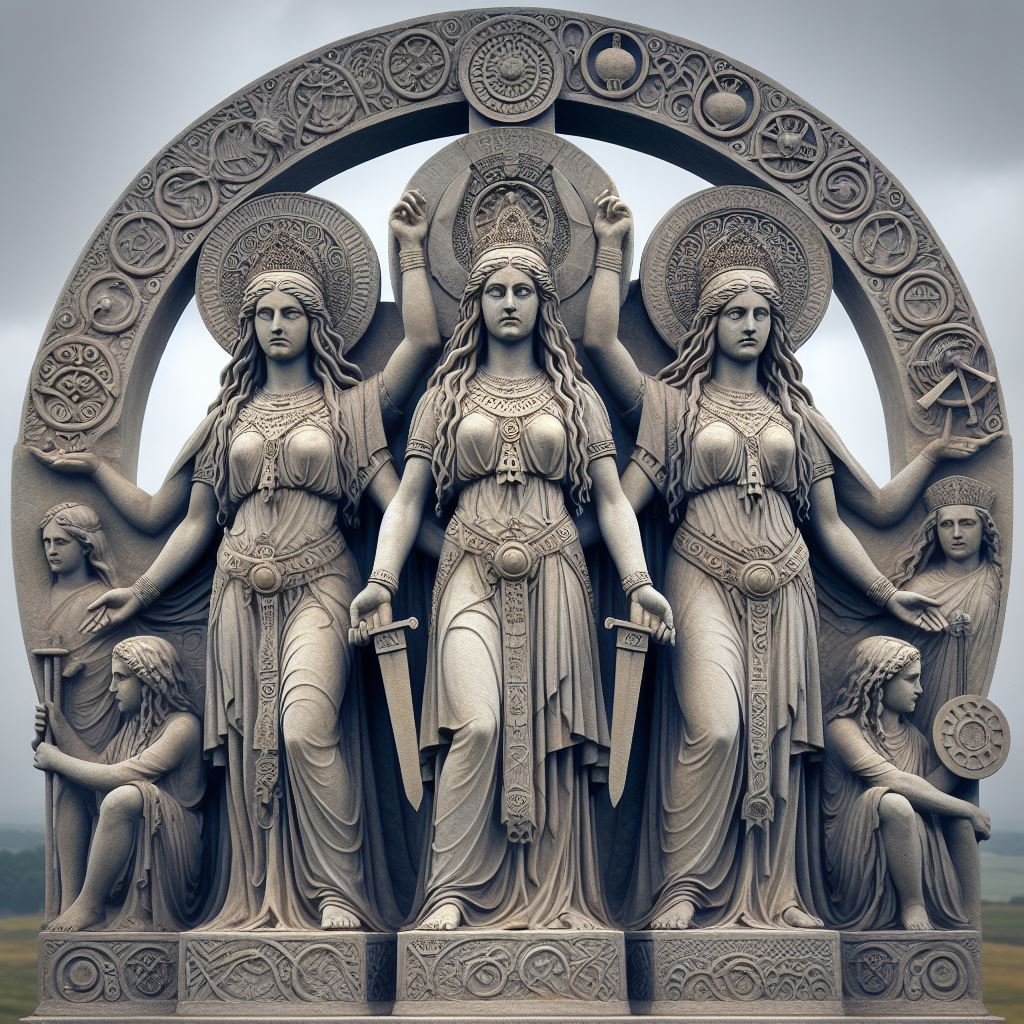
In this article, I hope to explore the Goddess Brigantia in quite some detail. Whilst there is very little information available to use directly regarding Brigantia, we can look at other Goddesses in related cultures, and draw parallels and comparisons that may help us clarify exactly who Brigantia was.
Brigantia is a goddess from the Celtic pantheon, and is a figure shrouded in mystery. Her name is thought to mean “The High One,” and she is associated with the land and sovereignty. She was venerated in various locations across the Celtic world, and her worship seems to have been particularly significant in the region of the Brigantes, a tribe in what is now Northern England. Inscriptions and statues provide some evidence of her worship, suggesting she was depicted with a crown, possibly of light or fire, and holding a spear and a globe, symbols of victory and protection.
The concept of the Triple Goddess, which embodies the threefold aspects of maiden, mother, and crone, is indeed a recurring theme in various spiritual and mythological traditions around the world. This archetype serves as a symbol of the full cycle of life and the different stages of womanhood, each aspect holding its own unique attributes and wisdom. In the context of Irish deities, this triadic nature is prominently seen in figures such as Brigid, who is associated with healing, poetry, and smith craft, representing the multifaceted roles of women in society and the divine. The prevalence of triple goddesses across different cultures suggests a universal recognition of the complexity and diversity of the feminine divine, reflecting a deep-rooted psychological and sociological significance.
In relation to the Goddess Brigantia, she is also connected to the concept of the triple goddess. Brigantia, a deity from Celtic (Gallo-Roman and Romano-British) religion, was associated with the Brigantes tribe and was revered in various regions, including Ireland and Britain. She was often equated with the Roman goddesses Minerva, Victoria, and Fortuna, indicating her diverse domains of influence, which included wisdom, victory, and fortune. The inscriptions and iconography found across Britain suggest that Brigantia was a significant deity with a wide range of attributes, possibly encompassing the qualities of the triple goddess within her own cult and worship.
If we look at the Irish Celtic pantheon, we can see that there is a strong relationship, and claimed identity, between Brigantia and Brigid. Let’s look into that.
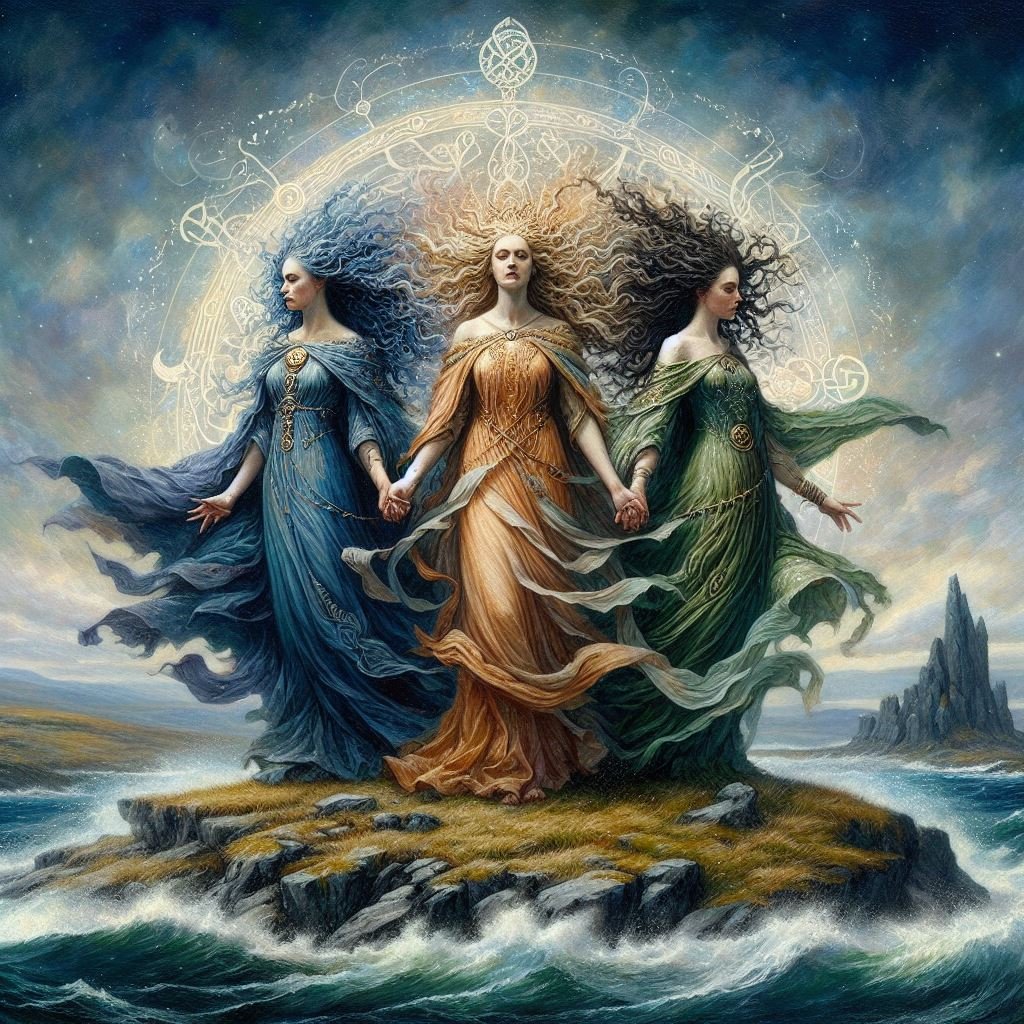
Triple Goddesses in Ireland
In Irish mythology, the figures of The Mórrígan and Brigid stand as prominent examples of the triple goddess archetype, embodying various aspects of the divine feminine. The Mórrígan, often associated with war, fate, and sovereignty, is sometimes depicted as a trio of sisters, each representing a different aspect of her dominion. This tripartite nature underscores her complex role within the pantheon, intertwining themes of protection, prophecy, and the life-and-death cycle. Brigid, conversely, is revered as a goddess of poetry, healing, and smith craft, with her triple aspects frequently referred to as three sisters or expressions of the same deity, symbolizing her multifaceted influence over creativity, nurturing, and craftsmanship.
The honouring of these deities in their triple forms varies, with rituals and celebrations reflecting their diverse attributes. For instance, Brigid is celebrated during Imbolc, a festival marking the beginning of spring, highlighting her connection to new life and fertility. The Mórrígan’s aspects are often acknowledged in relation to sovereignty and the protection of territory, with her presence invoked to ensure victory and guidance in warfare.
The origins of these goddesses are deeply rooted in the mythological cycles of Ireland, with The Mórrígan linked to the Tuatha Dé Danann, a mythical race of deities, and Brigid considered a daughter of the Dagda, a prominent figure within the same pantheon. Their stories are interwoven with the land’s history and culture, reflecting the Ancient Celts’ understanding of the divine and its manifestation in the natural world.
Other feminine triple archetypes in Irish mythology include figures such as the Cailleach, representing the destructive forces of nature and the cycle of life and death, and Epona, associated with horses and fertility. These archetypes underscore the Celts’ reverence for the number three, often symbolizing the stages of life, the natural elements, and the passage of time within their mythological framework.

Brigid
Brigid, a prominent figure in Celtic mythology, is often celebrated as a triple goddess, embodying the attributes of the maiden, mother, and crone. This tripartite nature symbolizes the full cycle of life, representing youth and potential, adulthood and fertility, and wisdom and the end of cycles, respectively. In her maiden aspect, Brigid is associated with new beginnings and the promise of youth, akin to the waxing phase of the moon. As the mother, she embodies nurturing, fertility, and the power of creation, paralleling the full moon’s luminescence. The crone aspect, linked to the waning crescent, signifies the culmination of wisdom acquired through life’s experiences. These aspects are reflective of the broader concept of the triple goddess in neopagan traditions, where such figures are seen as representing the stages of a woman’s life and phases of the moon.
The mother aspect of Brigantia, like Brigid’s, is tied to the land’s fertility and the well-being of its inhabitants. The crone aspect, embodying wisdom and foresight, is crucial for the protection and guidance of the community. Brigantia’s triple aspects also align with the natural world’s cycles, emphasizing the interconnectedness of life and the land.
The reverence of Brigid and Brigantia in their triple forms underscores the importance of the number three in Celtic and neopagan belief systems, symbolizing balance and completeness. The triple goddess motif is a powerful representation of the dynamic and cyclical nature of existence, resonating deeply within the spiritual practices that honour these deities. For further reading on Brigid’s triple goddess aspect, Mythopedia provides a comprehensive overview, while Mythology Source offers an in-depth guide. Additionally, Wicca Academy delves into the significance of the triple goddess within Wiccan practices. For insights into the maiden, mother, and crone, Wind Hughes’ article provides a detailed exploration.

The Morrigan
The Morrígan, a prominent figure in Irish mythology, is often associated with war and fate, particularly with foretelling doom, death, or victory in battle. She is depicted as a crow, symbolizing her role as a harbinger of war (Wikipedia, n.d.). The Morrígan is frequently described as a trio of individuals, all sisters, known as “the three Morrígna” which includes Badb, Macha, and Anann or Nemain, with some sources suggesting these names may represent the same deity (The Irish Pagan School, n.d.; Wikipedia, n.d.). This triadic nature aligns with the concept of the Triple Goddess in Neopagan traditions, which embodies the stages of the female life cycle and the phases of the Moon, represented as the Maiden, the Mother, and the Crone (Wikipedia, n.d.).
The Maiden aspect, symbolizing youth and new beginnings, parallels the Morrígan’s aspect of Badb, representing fury and the potential for change in battle. The Mother, embodying maturity, fertility, and power, can be seen in Macha, who signifies sovereignty and protection. The Crone, associated with wisdom, the end of cycles, and preparation for rebirth, is reflected in Anann or Nemain, indicating the Morrígan’s role in fate and death (Irish Graves, 2024). These aspects not only signify different stages of life but also the Morrígan’s influence over the land and its people, as she is also considered a guardian of territory (Wikipedia, n.d.).
In relation to Brigantia, a goddess from the Brigantes tribe in Britain, the Maiden, Mother, and Crone aspects can be seen as parallel to the Morrígan’s aspects. The Maiden aspect, symbolizing youth and new beginnings, can be likened to Badb’s role in inciting warriors to battle. The Mother aspect, representing fertility and protection, aligns with Macha’s association with sovereignty and the protection of the land. Lastly, the Crone aspect, embodying wisdom and the end of cycles, parallels Anann’s connection to the land’s prosperity and the inevitable cycle of life and death (Wicca Academy, n.d.).
The synthesis of these aspects between the Morrígan and Brigantia highlights a broader theme within Celtic mythology, emphasizing the interconnectedness of life’s stages and the natural world. The Morrígan’s multifaceted nature as a triple goddess not only encapsulates the complexities of life but also serves as a guardian of the people and their territories, much like Brigantia’s role in her respective mythology (Celtic Native, n.d.).
For further reading on the Morrígan and her aspects, one might explore the detailed accounts available on Wikipedia and The Irish Pagan School. Similarly, insights into the Maiden, Mother, and Crone aspects of Brigantia can be found through resources such as the Wicca Academy and The Bridging Tree. These sources provide a deeper understanding of the deities’ roles and significance within their cultural contexts. It is through such exploration that one can appreciate the rich tapestry of symbolism and meaning woven into the fabric of Celtic spirituality and mythology.
What can we say about Brigantia, in relation to The Mórrígan and Brigid?
The intertwining of deities in ancient cultures often reflects a complex spiritual landscape where attributes and stories may overlap. In the case of Brigantia, there is indeed evidence to suggest a syncretism with both The Mórrígan and Brigid. Brigantia, shares several attributes with Brigid, such as the association with victory and a perpetual flame, which is a central aspect of Brigid’s worship (Celtic Roundhouse, n.d.). Furthermore, the Romans, through the practice of interpretatio Romana, identified Brigantia with their own goddesses Minerva, Fortuna, and Victoria, which aligns with The Mórrígan’s aspect of victory (Celtic Roundhouse, n.d.; Oxford Reference, n.d.).
The suggestion that Brigantia embodies both The Mórrígan and Brigid in the Northern British understanding is supported by the fact that Brigantia was venerated throughout the Iron Age world under various names, including Birgit, Brigid, and Bride, indicating a shared cultural reverence across regions (Roman Britain, n.d.). Additionally, the three-fold nature of these goddesses, a common theme in Celtic spirituality, further supports the idea of a composite deity. The concept of a triple goddess, representing the unity of three separate entities, aligns with the depiction of Brigantia as a multifaceted figure embodying various aspects of sovereignty, war, and wisdom.
Inscriptions and archaeological findings provide tangible evidence of Brigantia’s worship and her connection to other deities. For instance, inscriptions dedicated to Brigantia have been found in Britain, some of which refer to syncretization with Roman deities, suggesting a blending of attributes and roles (Albion and Beyond, n.d.). The iconography found on altars and statues, such as the depiction of Brigantia with a crown of fire or light and holding a spear and a globe of victory, further cements her association with both martial success and the perpetual flame of Brigid (Celtic Roundhouse, n.d.).
The scholarly debate continues regarding the exact nature of the relationship between Brigantia, The Mórrígan, and Brigid. Some scholars, like Dáithí O hOgain, propose that the migration of the Brigantes tribe to southeastern Ireland in the 1st century may have brought the worship of Brigantia to Ireland, where she became associated with Brigid (Celtic Roundhouse, n.d.). This historical migration could explain the shared attributes and the presence of a composite deity in the Northern British and Irish spiritual traditions.
While the evidence does not provide a definitive answer, it strongly suggests that Brigantia was a composite deity in the Northern British understanding, embodying aspects of both The Mórrígan and Brigid. This synthesis of deities reflects the fluid and interconnected nature of Celtic spirituality, where gods and goddesses often merged and evolved in response to cultural and societal changes. For further reading and a deeper dive into the evidence, the following resources offer extensive information: Celtic Roundhouse, Roman Britain, and Albion and Beyond.
Other Irish Deities with triple Goddess qualities
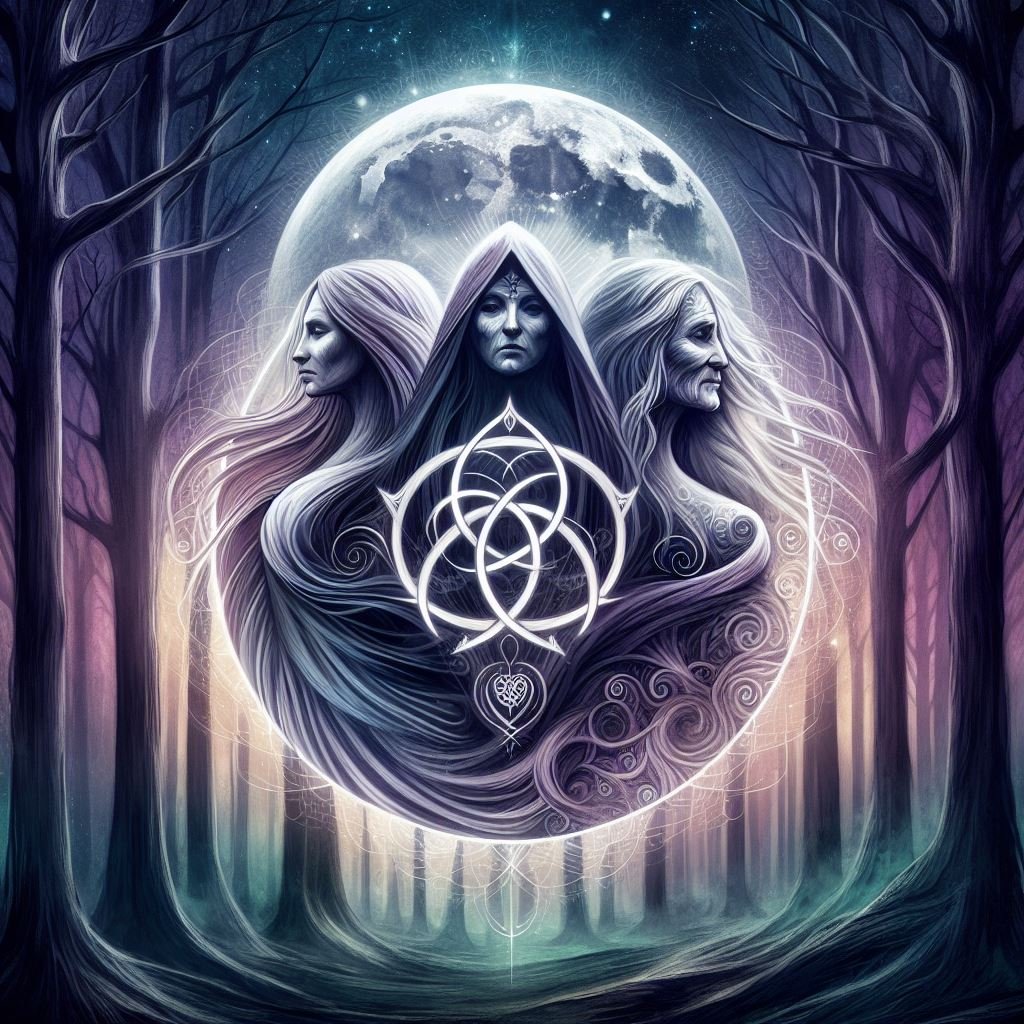
The Cailleach
The Cailleach is a profound figure in Irish, Scottish, and Manx mythology, often depicted as a divine hag and an ancestor spirit. Her name, derived from the Old Irish ‘Caillech’ meaning ‘veiled one’, is indicative of her enigmatic nature and her association with the wild, untamed aspects of the world. As a creator deity, the Cailleach is intimately connected with the shaping of the landscape and the governance of the weather, particularly storms and winter. She is the embodiment of the destructive forces of nature, yet also its guardian, ensuring the cycle of life and death continues unabated.
In the lore of these Gaelic cultures, the Cailleach is sometimes portrayed with only one eye, a testament to her role as a seer of the hidden truths of the universe. Her skin is often described as pale or blue, symbolizing her dominion over the cold, and her attire is said to be adorned with skulls, signifying her connection to death and the afterlife. Despite her fearsome appearance, the Cailleach is also a protector of animals during the harsh winter months, embodying the duality of nurturing and destruction.
The Cailleach is a figure deeply rooted in Celtic mythology, often associated with the personification of the natural landscape, winter, and the transformation of seasons. Her name, derived from the Gaelic word for ‘old woman’ or ‘hag,’ signifies her role as an ancient deity of sovereignty and wilderness (History Cooperative, 2024). The Cailleach’s triple goddess aspects align her with the stages of life: the maiden, representing youth and new beginnings; the mother, symbolizing fertility and creation; and the crone, embodying wisdom and the end of cycles (Moonfall Metaphysical, 2023). This trinity mirrors the mother, maiden, crone model prevalent in various mythologies, where each aspect reflects a phase of the female life cycle and a corresponding phase of the moon (Wikipedia, n.d.).
Brigantia shares similarities with the Irish Brigid and is often associated with the attributes of sovereignty, war, and fertility. Brigantia’s connection to the land and sovereignty aligns her with the Cailleach’s domain over nature and the landscape (Celtic Roundhouse, 2022). Furthermore, the seasonal division between the Cailleach, ruling winter, and Brigid, ruling summer, highlights a duality that reflects the changing faces of the goddess with the seasons (Mythopedia, 2022).
In exploring the relationship between the Cailleach and Brigantia, one can observe the fluidity of divine feminine representation in Celtic mythology. The Cailleach’s triple aspects resonate with the mother, maiden, crone model, emphasizing the cyclical nature of life and the goddess’s influence over it. Brigantia, complements this framework with her own attributes and domain, enriching the tapestry of Celtic divine femininity.
The interweaving of these goddesses’ attributes and domains underscores the complexity and depth of Celtic mythology and its reverence for the natural world and the divine feminine within it. The Cailleach and Brigantia, through their distinct yet interconnected roles, embody the multifaceted nature of the goddess, reflecting the myriad ways in which the divine feminine manifests across cultures and traditions. Their stories and attributes continue to inspire and inform contemporary understandings of spirituality, mythology, and the celebration of the cycles of life and nature.
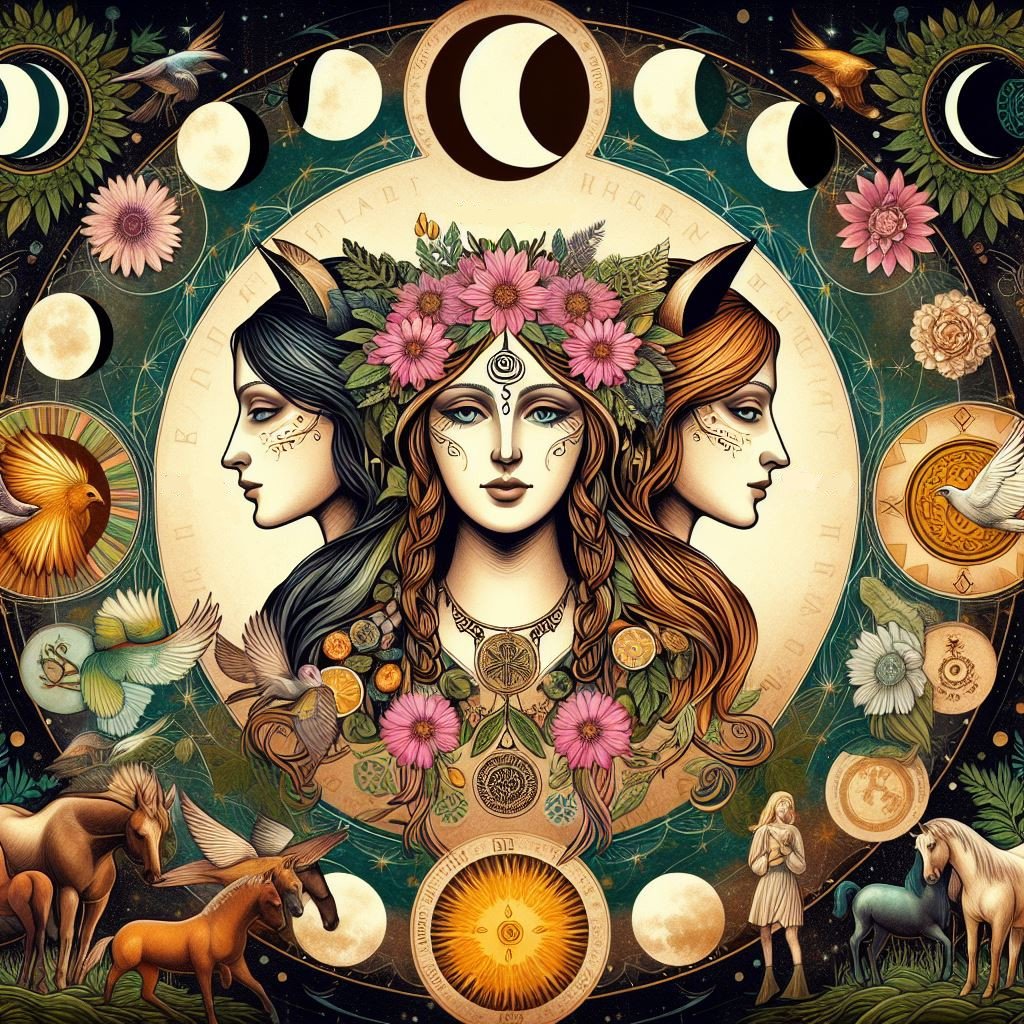
Epona
Epona, a deity of Celtic origin, is often associated with horses and sovereignty, and while not traditionally categorized under the triple goddess model, her attributes align with the fertility and nurturing aspects of the mother. Epona’s worship extended into the Gallo-Roman period, where she was revered for her connection to equine prosperity and as a protectorate of horses, symbolizing fertility and abundance.
In relation to Brigantia, a goddess from Northern England, there are parallels to be drawn. Brigantia, like Epona, was associated with sovereignty and protection, and her worship included aspects of victory and celestial power. The interpretatio Romana linked Brigantia with Roman goddesses such as Minerva and Victoria, indicating a shared domain of influence and reverence.
The synthesis of these goddesses with the mother, maiden, crone model can be seen through their shared attributes of fertility, protection, and sovereignty. The mother aspect is evident in their nurturing and fertile qualities, while the crone’s wisdom and transformation can be reflected in their roles as sovereign protectors and guides for both humans and animals.
Although Epona is not explicitly described within the triple goddess framework, her characteristics resonate with the model’s themes of life cycles and transitions.
The enduring legacy of these goddesses in modern paganism and their integration into contemporary spiritual practices demonstrate the fluidity and adaptability of ancient archetypes to modern contexts.
In academic and spiritual explorations, it is crucial to approach these connections with a nuanced understanding of cultural specificity and historical context. The triple goddess model, while a useful tool for interpretation, should not overshadow the unique identities and cultural significance of individual deities such as Epona and Brigantia.
For further reading on the complexities of these goddesses and their roles within Celtic and Gallo-Roman religion, as well as their relation to the triple goddess model, resources such as Old World Gods, Legendary Ladies Hub, and Wikipedia articles on Epona and Brigantia provide comprehensive insights. These sources offer a deeper dive into the mythology, worship, and symbolism associated with these powerful figures, enriching our understanding of their enduring influence.
Could Brigantia also embody The Cailleach and Epona?
While there is no concrete evidence to conclusively state that Brigantia embodies the Cailleach and Epona, the overlapping themes of sovereignty, protection, and life cycles present in their mythologies allow for such an interpretation within the Northern British context. The fluid nature of Celtic deity worship, with its emphasis on natural cycles and the interconnectedness of life stages, supports the idea that Brigantia could represent a synthesis of these goddesses, embodying their combined strengths and domains.
Brigantia’s relationship to the Classical pantheons
As well as Irish Celtic mythology, we can also relate the Goddess Brigantia to the Roman and Greek pantheons.
Minerva, Victoria and Fortuna
Minerva, in Roman religion, was the goddess of wisdom, war, and crafts, often associated with the Greek goddess Athena. Victoria was the personification of victory, both military and personal, while Fortuna was the goddess of fortune and the personification of luck. The connection between these Roman deities and the Brigantian concept of maiden, mother, crone is not directly evident in classical sources but can be inferred through the overlapping domains of these goddesses with the life stages and roles represented by the triple aspect of Brigantia. The maiden aspect, symbolizing youth and potential, aligns with Minerva’s association with wisdom and the early stages of learning. The mother aspect, embodying maturity and fertility, resonates with Fortuna’s role in determining the prosperity and well-being of both individuals and the state. Finally, the crone aspect, representing wisdom and the culmination of life, can be seen in the victorious culmination of efforts symbolized by Victoria.
The Brigantian concept of maiden, mother, crone is reflective of the Triple Goddess archetype found in various Neopagan traditions, which represents the three stages of a woman’s life. The maiden is associated with new beginnings and youth, the mother with nurturing and fertility, and the crone with wisdom and the end of cycles. This triadic nature can be seen as a reflection of the natural cycles of life, death, and rebirth, and the phases of the moon—waxing, full, and waning. In this context, Brigantia’s association with Minerva, Victoria, and Fortuna can be interpreted as embodying the attributes of the maiden, mother, and crone, respectively, each deity bringing forth different strengths and qualities that resonate with the different stages of life and aspects of the divine feminine.
While the Roman deities Minerva, Victoria, and Fortuna each have distinct roles within Roman mythology, their attributes and spheres of influence can be conceptually linked to the Brigantian concept of maiden, mother, and crone. This linkage provides a rich tapestry of symbolism and meaning, reflecting the multifaceted nature of the divine feminine and its expression through various cultural lenses. The interpretatio Romana thus serves as a bridge between cultures, allowing for a more profound understanding of the shared human experience of the divine.
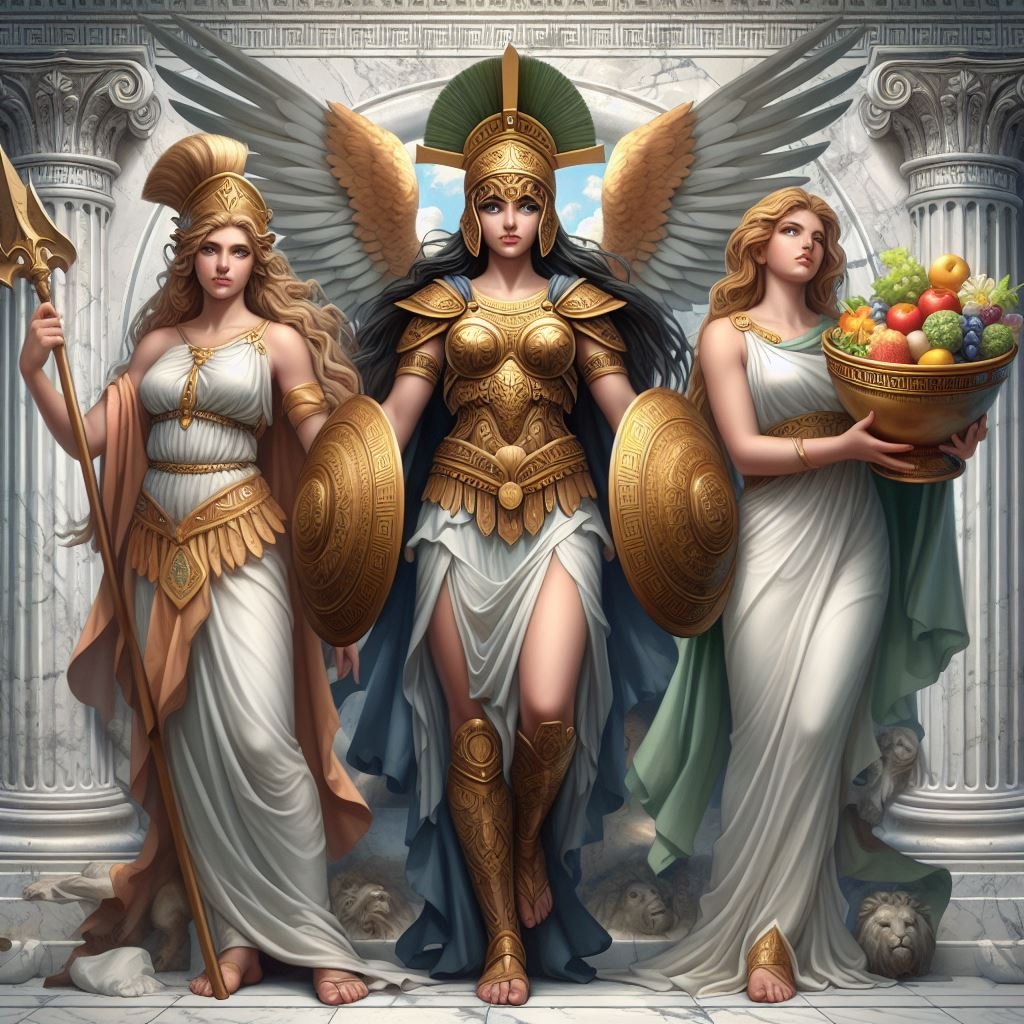
Athena, Nike, and Tyche
In the intricate tapestry of ancient mythology, the Roman goddesses Minerva, Victoria, and Fortuna are closely intertwined with their Greek counterparts and the broader pantheon. Minerva, the Roman goddess of wisdom, war, and crafts, parallels the Greek Athena, known for her strategic prowess and intellectual guidance. Both deities embody the archetype of the maiden in their perpetual virginity and youthful vigor, symbolizing new beginnings and potential. Victoria, the embodiment of victory, finds her likeness in Nike, the Greek goddess who personified triumph in both war and peaceful competition. This aspect resonates with the mother figure, representing the fulfilment and nurturing of ambitions. Fortuna, the capricious goddess of fortune, mirrors the Greek Tyche, who governed the prosperity and fate of individuals and cities. They reflect the crone’s wisdom and acceptance of life’s unpredictability.
In the pantheon of Greek deities, Athena, Nike, and Tyche hold significant roles that align with the aspects of the Brigantian concept of maiden, mother, and crone. Athena, the goddess of wisdom and warfare, is often associated with the maiden aspect due to her virginity and the qualities of independence and strength she embodies. She represents the youthful and assertive energies that are characteristic of the maiden stage in the triple goddess archetype. Nike, as the personification of victory, can be seen as an extension of Athena’s attributes, symbolizing the triumph and success that come with experience and maturity, akin to the mother aspect. Tyche, the goddess of fortune and prosperity, encompasses both the positive and negative aspects of chance, reflecting the wisdom and unpredictability of the crone.
The relationship between these Greek goddesses and the Goddess Brigantia, can be understood through the lens of syncretism, where different cultures’ deities and mythologies merge and influence one another. Brigantia, who was associated with sovereignty, war, and prosperity, shares attributes with the Greek goddesses mentioned. The concept of the triple goddess, which encapsulates the stages of womanhood as maiden, mother, and crone, is a theme that resonates across various cultures and mythologies, including Greek and Celtic. In this context, Brigantia could be seen as a composite figure who embodies the attributes of these Greek goddesses, representing the full spectrum of the female divine from youth to maturity to wisdom.
While Athena, Nike, and Tyche are distinct entities within Greek mythology, their attributes and domains can be conceptually linked to the Brigantian understanding of the divine feminine through the stages of life they represent.
For further reading on the Greek goddesses and their attributes, the following sources provide detailed information: Tyche’s dual role as a bringer of both fortune and misfortune is discussed in depth on the Greek Gods and Goddesses website. The intertwined myths of Nike and Athena, and their roles in ancient Greek society, are elaborated on History Defined. The concept of the triple goddess in neopagan traditions, which includes the maiden, mother, and crone, is explored on Wikipedia and Learn Religions. These resources offer insights into the complexities of these deities and their potential connections to the figure of Brigantia. It is important to note that while these connections are speculative and based on thematic similarities, they provide a rich tapestry for understanding the evolution and syncretism of mythological figures across different cultures.
The triple Goddess in Christianity
In the exploration of the Triple Goddess archetype within the Christian pantheon, where Mary Magdalene is identified with the Maiden and the Virgin Mary with the Mother, the figure of the Crone would symbolize wisdom and the culmination of life’s journey. A potential representation of the Crone could be hypothesized as Saint Anne, the mother of the Virgin Mary, who embodies the maturity and wisdom often associated with the Crone aspect of the Triple Goddess. This interpretation aligns with the understanding that the Crone represents the later stage of life, characterized by insight and experience gained over a lifetime (Otherworldly Oracle, 2020). The Crone is revered within various spiritual traditions for her guidance, transformational knowledge, and association with the waning phase of the moon, which corresponds to the later years in the cycle of life (Meaningful Moon, 2024).
In the context of Christianity, while the Triple Goddess is not explicitly represented, elements of her can be traced in various figures, such as the saints and holy women, who embody the qualities of the Maiden, Mother, and Crone. The integration of the Triple Goddess into Christian iconography is a subject of scholarly debate and personal interpretation, often explored through the lens of comparative mythology and feminist theology (Shamanic Garden, 2023).
In academic discussions, it is essential to approach such syncretism with a critical understanding of both the original contexts of the Triple Goddess and the theological framework of Christianity. The Triple Goddess serves as a powerful symbol of the stages of womanhood and the cyclical nature of life, resonating with individuals who seek a more inclusive and holistic spirituality (Spells8, 2022). For those interested in further exploring this topic, the provided references offer a comprehensive examination of the Triple Goddess symbol and its meanings across cultures and time periods.
Other examples of the triple Goddess in mythologies and beliefs around the world
Hinduism: The Tridevi consists of Saraswati, Lakshmi, and Parvati, representing wisdom, wealth, and power respectively.
Norse Mythology: The Norns are three sisters who weave the destiny of gods and men.
Greek Mythology: Hecate is sometimes presented in triple form and is associated with crossroads, entrance-ways, light, magic, witchcraft, knowledge of herbs and poisonous plants, ghosts, necromancy, and sorcery.
Roman Mythology: Diana is revered in triple form as Diana, Luna (the moon), and Hecate.
Slavic Mythology: The Zorya are three guardian goddesses, representing morning, evening, and midnight.
Egyptian Mythology: The goddesses Isis, Bastet, and Hathor have been grouped together in various triads throughout history, representing different aspects such as motherhood, fertility, and the domestic sphere.
Welsh Mythology: The goddesses Blodeuwedd, Arianrhod, and Ceridwen are sometimes considered as aspects of a triple goddess, representing the earth, the stars, and the moon respectively.
Sumerian Mythology: Inanna, Ereshkigal, and Ninhursag are powerful deities who have been interpreted as a triad representing heaven, earth, and the underworld.
Conclusion
These examples illustrate the widespread presence of the triple goddess motif across various cultures and religions, symbolizing a range of concepts from creation, protection, and destiny, to wisdom, death, and rebirth. The triple goddess often embodies the full cycle of life and the feminine divine, reflecting the complexity and diversity of the roles women play in society and mythology.
We have discussed at length how Brigantia has been related to various triple Goddess trinities, and I suggest that there is strong evidence to suggest that Brigantia, as represented in Northern Britain, was a triple Goddess that may well have embodied all the functions we see embodied by individual triads elsewhere. Whilst it is difficult to create a definitive list of attributes and qualities, it is clear that Brigantia definitely embodies some qualities embodied elsewhere be separate deities.
If you want to dig deeper into Brigantia, there are some good online resources you can visit. For instance, the Wikipedia page on Brigantia offers a comprehensive overview of the historical and archaeological evidence of her worship. Another resource, the Celtic Roundhouse blog, delves into the legacy of Brigantia and attempts to revive her lost wisdom, discussing her significance to the Brigantes tribe and the possible connections to other deities like Brigid. The Roman Britain website provides insights into Brigantia’s role as the patron deity of the Brigantes and her association with wisdom and memory. Firetree, a site dedicated to the Celtic wheel of the year, explores Brigantia’s symbolism and her representation of the land’s sovereignty. Lastly, Britannica offers a concise summary of her attributes and her connection to water, as well as the naming of several rivers in Britain and Ireland after her.
These resources, while varied in their approach, all contribute to a richer understanding of Brigantia. They offer a blend of historical data, interpretative analysis, and modern devotion, reflecting the ongoing fascination with and reverence for this ancient goddess. Her story, though fragmented, continues to inspire and resonate with those seeking to connect with the spiritual heritage of the British Isles. Exploring these sites can provide a multifaceted view of Brigantia, piecing together the puzzle of her identity and significance in the ancient world and her lasting impact on contemporary spiritual practices.

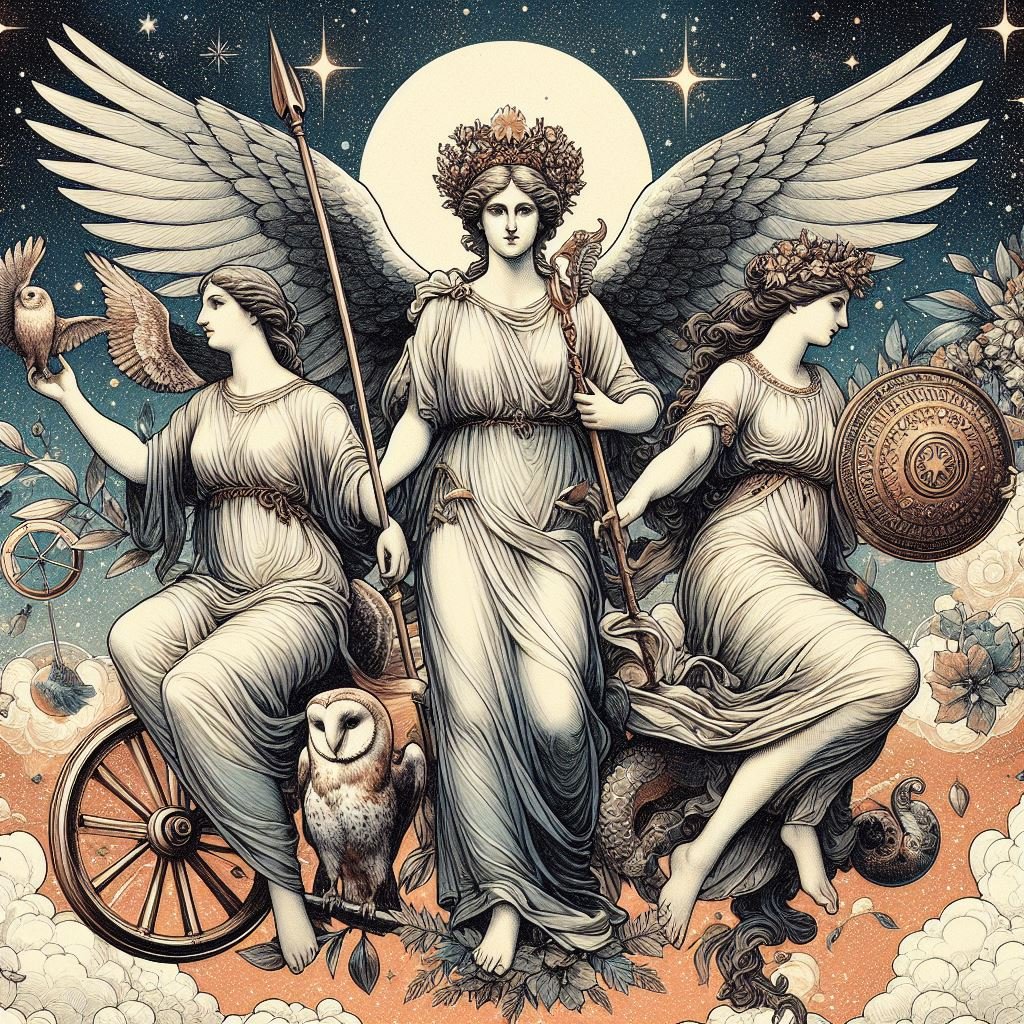
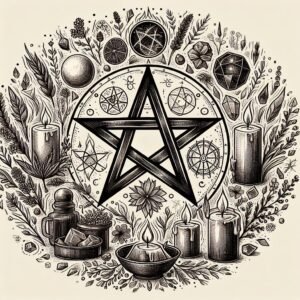
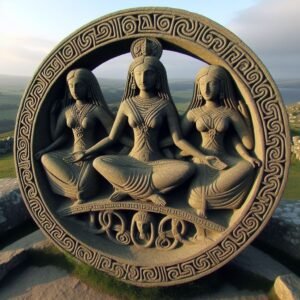
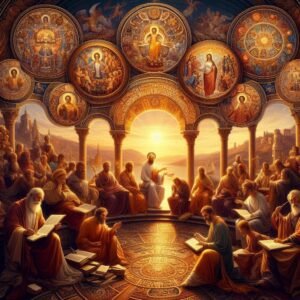
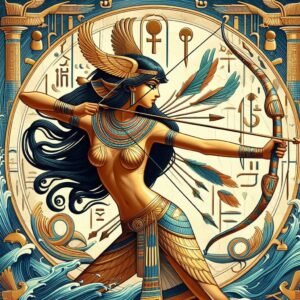


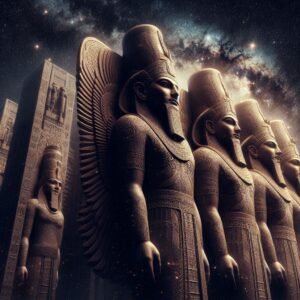

Truth of Self › Forums › Discovering the triple Goddess Brigantia
Tagged: apona, Athena, Brigantes, brigantia, brigid, christianity, fortunanike, goddess, hindu, minerva, northern England, the cailleach, The Morrigan, trinity, triple goddess, tryche, victoria, Victory